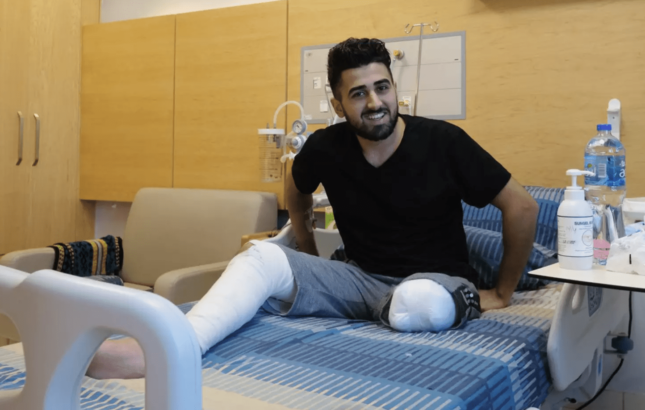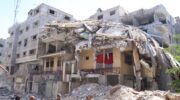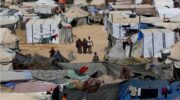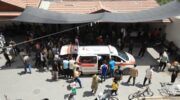Gaza journalist Yousef Kronz at the hospital. Credit: Alex Levac
Yousef Kronz was sitting on the ground well within Israel’s designated “safe zone,” wearing a Press vest, taking photos. When he stood up, he was shot in both legs by two different snipers. Another young man ran to help him, only to be shot in the leg as well. Adding insult to injury, Israel refused him passage to the West Bank for treatment that would have saved at least one of his legs.
Israel advocates might consider it “restraint” that these young men weren’t shot in the head, but the question hangs in the air: why was this life-changing horror inflicted on Yousef – and thousands of others – as they did nothing more scandalous than carry flags run around, pray, demonstrate, or take photos in the shadow of Israel’s violent oppression?
by Gideon Levy and Alex Levac, Ha’aretz
His left leg was amputated in Shifa Hospital in the Gaza Strip, and now efforts are underway, in Istishari Arab Hospital in the West Bank, to ensure that his right leg doesn’t suffer the same fate. More than two weeks passed between the amputation of the first leg – which itself could have been prevented – and the action undertaken to save the other one. Precious time in which Israel refused to allow Yousef Kronz, the first Palestinian seriously wounded during the recent weekly protests in the Gaza Strip, to be moved to the hospital outside Ramallah. The High Court of Justice finally forced the Defense Ministry to bring this disgraceful conduct to an end and allow the transfer of the 19-year-old student and journalist from Bureij refugee camp, to that more sophisticated facility.
On Friday, March 30, Kronz was shot, first in the left leg, by an Israel Defense Forces sniper, and then, seconds later, when he tried to get up, in the right leg, by a second sniper. According to Kronz, the rounds that slammed into his legs and shattered his life came from two different directions. In other words, he was shot by two different marksmen, as he stood 750 meters away from the Gaza border fence, armed with no more than his camera, wearing a vest with “Press” emblazoned on it, trying to document the incessant firing by IDF snipers at unarmed Palestinian demonstrators. After he was hit, he tells us now, he saw more and more people falling to the sand, bleeding, “like birds.”
The incident occurred on Land Day, the first day of the Marches of Return opposite the Gaza fence.
Istishari Hospital is situated high in the village of Surda, north of Ramallah. It’s a large, new, sophisticated private facility, luxurious and glistening. Kronz has a private room, spacious and well-lit with an adjustable bed, a television, wood-paneled walls and a breathtaking view. Israel did not allow anyone from his family to accompany Kronz to the West Bank or tend to him, other than his grandfather, Mohammed Kronz, who’s 85, and who, after a few days, was compelled to go to the home of relatives in the distant Aroub refugee camp, near Bethlehem, to rest. Now Yousef, who is suffering from serious pain in his stump and in his remaining leg, is being looked after with infinite devotion by a cousin, Ghassan Karnaz, who is also from Aroub.
The two cousins had never met before. Like all the young people in Gaza, Kronz had never been outside the Strip. Now he’s breached the siege on it – without his leg.
A first-year communications student at Al-Azhar University in Gaza, he is from a family that hails from Faluja, in the Negev. His father receives his salary as a Gaza-based police officer from the Palestinian Authority. Kronz was active in the social networks, reporting on the situation in the Strip. A few months ago, he purchased a Canon 5D stills camera for $5,000, half of it from savings, the rest from his father, and started to work for the local Bureij news agency.
Kronz was the first journalist shot during the month of demonstrations, though not the last. He was well acquainted with Yaser Murtaja, a journalist killed in cold blood by IDF snipers on April 6. Like Kronz, Murtaja too was from a Gaza refugee camp – Jabalya.
On March 30, Kronz walked about 1.5 kilometers from his home to the site of the demonstrations to photograph them for his news agency. He recited the midday prayers in the journalists’ tent set up there. The 25 local reporters then discussed how they would divide up the arena of the protests they were documenting. The atmosphere was tense, he recalls now; everyone expected large numbers of casualties.
Did he think the IDF would use live ammunition? “The IDF always fires live ammunition.” His face is contorted with pain, but Kronz is well groomed, despite his condition. He constantly glances at the mirror or at the camera in his cellphone, to be sure his designer haircut looks okay.
After the prayers, he continues, the young people started to set fire to tires. Signs set up by the organizers showed the way to the toilets and various tents, and also the distance from the border fence at each point. Thus Kronz knew he was 750 meters away from the barrier. The day before, the IDF had dropped leaflets in nearby Jabalya warning that anyone who came closer than 300 meters from the fence would be risking his life. With plenty of experience under their belts, Gazans take those warnings seriously. The organizers marked a permitted green zone and a forbidden, and dangerous, red zone. Karnaz says he was hundreds of meters outside the boundary of the red zone.
At 2 P.M., the situation reached a boiling point. IDF troops started to hurl tear-gas grenades as young people approached to within 100 meters of the fence. They used slingshots to hurl stones at the soldiers but were too far away to hit them. Karnaz says he saw a few dozen soldiers opposite him on the other side of the barrier; three jeeps and the barrel of a tank were peeking out from behind an embankment. He too found a small dirt mound and perched behind it, placing the tripod with his camera on it to one side and his backpack on the other. He knelt on the sand, his legs crossed before him. The barrage of tear gas grew more intense, the soldiers fired the grenades in volleys, and the skies became covered with thick, burning gas. The wind carried the gas in his direction; demonstrators used onions to protect themselves from it.
Kronz took about 950 photos.
He remembers looking at his watch at 3 P.M. Later that afternoon, a friend, Bilal Azara, was getting married in Bureij, so he thought he should head home, shower and change. Kronz picked up his camera and backpack, and stood up. At that precise moment, the first bullet struck him. He didn’t hear anything but felt a searing pain. The camera was thrown from his hands and he collapsed, then immediately tried to get up. That’s when the second bullet ripped into his other leg. The first entered five centimeters below the knee, the second seven centimeters above the other knee. Paralyzed, he tried to shout for help but his voice betrayed him. He says he felt as if he’d been electrocuted. His camera was left behind in the sands of Gaza.
A few meters away was a young man of the same age, Ahmed al-Bahar, an assistant to one of the other photographers. Bahar ran to Kronz and tried to lift him up – but just then he too was shot in the leg and fell to the ground, bleeding.
At this point in our conversation, distant relatives of 11-year-old Abed al-Rahman Nufal, who also lost a leg in Gaza and is hospitalized here at Istishari, enter the room to say hello. Nufal is one of only three other wounded Gazans out of 1,500 wounded in the demonstrations to date, whom Israel has allowed to be moved here. The family, former Gazans now living in the West Bank, have come to see how the boy is doing.
Young people carried Kronz and Bahar to the only ambulance in the area. In short order the vehicle was crammed with six wounded people lying next to each other; Kronz was the most badly injured. The soldiers went on hurling tear gas; Kronz felt as if he was suffocating in the ambulance. A paramedic placed an oxygen mask on his face, but the crowding inside prevented him from staunching the bleeding from Kronz’s legs. Drifting in and out of consciousness, Kronz was taken to Al-Aqsa Hospital in Dir al-Balah.
At the hospital he saw his left leg for the first time; it was shattered, the bone protruding, the flesh lacerated. At the sight of it, he passed out. He was anesthetized and taken immediately to the larger Shifa Hospital in Gaza City, because of the severity of the wounds. At Shifa he underwent six hours of surgery to stanch the bleeding.
After four days in Shifa the condition of Kronz’s left leg deteriorated and the physicians were compelled to amputate it above the knee. He received 24 transfusions of blood. The request to transfer him to Ramallah for treatment was submitted to Israel just hours after he was wounded, but was rejected by the authorities. The situation of the right leg looked dire, as well.
Nine days after Kronz was wounded, on April 8, two rights groups – Adalah, the Legal Center for Arab Minority Rights in Israel, and the Gaza-based Al-Mezan Center for Human Rights – petitioned the Israeli High Court to allow Kronz and another wounded Gazan, Mohammed Alajuri, to be transferred urgently to Ramallah for treatment. The court apparently saw no real urgency in dealing with the case and waited four days before deliberating on the petition, whereupon the justices demanded a response from the state within four days.
“The amputations of the limbs of both young men could have been prevented if the state had fulfilled its obligation under humanitarian international law,” Sawsan Zahar, an attorney for Adalah, told the justices.
The state’s attorneys, for their part, told the court that, “On the surface, the petitioners’ condition appears to fulfill the medical criterion for receiving a permit [for transfer to Ramallah], but the authorized officials decided not to grant their requests. The main consideration for the refusal stems from the fact that their medical condition is a function of their participation in the disturbances.”
On April 16, Justices Uri Shoham, George Karra and Yael Willner said they were not persuaded that the government had fully considered whether the circumstances in Kronz’s case justified its deviation from normal procedure. “There’s no dispute over the fact that the medical treatment the petitioner needs to prevent the amputation of his leg is unavailable in the Gaza Strip,” they wrote. “Therefore, the petitioner is included among the cases in which entry to Israel is to be permitted for the purpose of passage to Ramallah.”
The justices also deigned to declare that Kronz does not represent a security risk to Israel. That same day, he was moved to Istishari Hospital. (As for Alajuri, before the court got around to issuing a ruling on his case, the doctors in Gaza had had no choice but to amputate his leg. He remains in Gaza.)
Yousef Kronz is now undergoing a rough patch, finding it difficult to adjust to being an amputee. Four days after being brought to the Ramallah hospital he underwent surgery on his right leg, whose condition appears to have been stabilized. Now, however, he faces lengthy rehabilitation, which will last at least four months, in a hospital in Beit Jala, adjacent to Bethlehem.
Before we take our leave, he asks us whether we think he’ll ever be able to walk on one leg.





